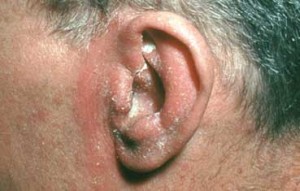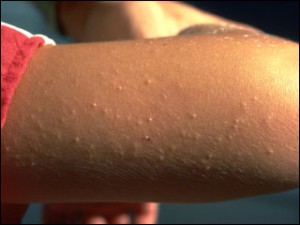I was recently asked by a reader about dry, itchy, scaly skin around and in the ears. This is a pretty common occurrence and can happen around the change of seasons, or when we start to go into these colder months, and it is usually at its worst during the winter. So what is this affliction? Seborrheic dermatitis. And it is pretty simple to clear up, and once you know the signs, you can prevent it from happening in the future!
What is Seborrheic Dermatitis?
It is a common skin disorder causing red, itchy, scaly, dry skin, which can cause dandruff (flaking of the skin). It’s really uncomfortable, and doesn’t look amazing, but it doesn’t have any long-term effects or cause any other health issues. It usually occurs on your scalp but it can be found anywhere on the body there are a high number of sebaceous (oil) glands (i.e. between eyebrows, chin, nose,ears, groin area, & chest.) Also, it is NOT contagious, so rest assured that you cannot “give” this skin issue to anyone else!
What are the symptoms?
Well, it usually occurs in areas of high oil glands (head, chest, ears, eyebrows, chin, nose, groin, scrotum, or armpits), and has a red, dry, scaly appearance. But it can vary on people, so some of the symptoms you might see are:
– Inflammation with redness of the skin
– Dandruff (flakes of skin) on your head, in eyebrows, beards/mustaches, etc.
– Red greasy patches of skin (scaly) that are covered in white flakes or yellow scales
– The areas can be sore, itchy, or feel raw (or a mixture if you scratch because it’s itchy it can become raw then sore)
– Crusts can appear on the scalp too
The most important thing to remember is that it can be a chronic condition that comes and goes, periods of inflammation, which usually occur with the change of seasons, and are worse in the cold weather months.
What causes it and how can I treat it?
It is sometimes caused by a (yeast) fungus that is naturally occurring in our sweat/oils called Malassezia, so it is basically a yeast infection of the skin, but with our own normal bacteria. So Over-The-Counter (OTC) treatments such as lotions/creams with an antifungal such as, ketoconazole (the same antifungal treatment for athlete’s foot or ringworm- like Lotrimin) will help to kill off the fungus and make the symptoms go away. It tends to occur more frequently in winter months for some reason, people with Parkinson’s disease tend to have a higher frequency of seborrheic dermatitis (it is not really understood why), and people with HIV/AIDS tend to get outbreaks more frequently (possibly due to a decreased immune response) and they have much more severe cases. Times of high stress can cause seborrheic dermatitis to occur as well, even if you have never had a problem with it before. Severe cases may need to be treated with Lamisil, an oral antifungal that is very strong and needs to be taken usually for a couple of months,and you need to abstain from alcohol. If it is merely itching and inflammation, you can use a hydrocortisone cream on top of the rash. Also, using medicated anti-dandruff shampoos that contain zinc pyrithione (in head and shoulders) or coal-tar (in Neutrogena T/Gel) on the affected areas can help. My suggestion is to use the medicated shampoos on the areas, and merely dry yourself after bathing, pat dry but don’t vigorously rub at your skin with the towel, and apply the topical creams (if needed). Start low and go slow is a good motto, try one treatment at a time, then add the others in slowly if you aren’t seeing results. Unfortunately, the reason that it occurs is not well-known, so if you get it, bummer, but at least you know how to treat it!
How is it diagnosed?
Your HCP will ask you about symptoms, where and when it occurs, if you have changed detergents/soaps/products recently to rule out that it is an allergic reaction to a new product. They will also perform an assessment on your scalp, and areas affected by the rash, to diagnose it. If they are not certain, based on physical assessment, of the diagnosis, they may do a biopsy, and when I say biopsy, I really mean a skin cell scraping; they just need to look at a few cells under the microscope to ensure that you do not have psoriasis or eczema instead (sometimes the rashes can mimic one another).
If you are diagnosed with seborrheic dermatitis, most likely you will be encouraged to try OTC treatments first, but there are prescription shampoos and creams that you may need to use, so tell your HCP if you have tried various OTC treatments and they just haven’t helped. Also, remember to avoid harsh soaps/detergents, you may want to switch to sensitive skin/hypoallergenic products to prevent skin irritation. If you have a mustache/beard/facial hair, shave it off; the more hair, the more oils that will be caught on your skin, and with hair there, it is tough to get the medication to have direct contact with the skin. Also try to wear breathable fabrics, if you get the issue in your armpits, groin, chest; cotton allows for more air flow, and hopefully less sweating! The best thing you can do is treat it when it comes, work with your HCP to find a medication regimen that works for you, and learn the warning signs that your skin gets before the rash erupts so you can start to preemptively treat it, and hopefully prevent the rash from getting into full swing! And who knows, maybe we will start to learn why this rash occurs, until then, just learn your skins signals!!
Yours in Good Health
B


